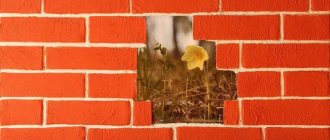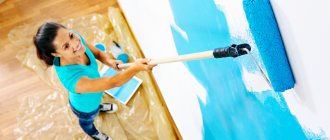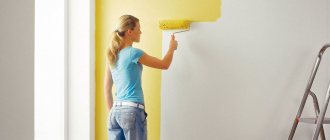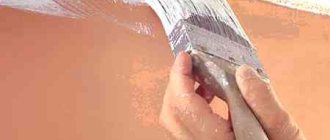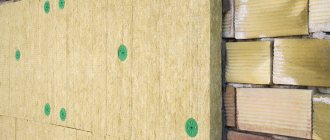0
05.01.2022
Painting walls is a great way to transform the interior and at the same time save a significant amount, because all the work can be done yourself. To perform high-quality surface finishing, you need to know which paint is best to choose and study the application technology.
Silicone compounds are considered the best
Types of wall paints and their features
Page navigation
Modern manufacturers offer a wide range of quick-drying and decorative paints, as well as matte and glossy surfaces. On sale are both compositions with a white base, for which colors can be used, and ready-to-use ones in a wide color palette.
Alkyd
The composition of the paint includes alkyd varnishes, solvents, fillers and pigment, which gives color.
Some manufacturers add antiseptics to their products, which protect surfaces from the formation of pathogenic microorganisms.
The coating can be used on any substrate. It is moisture resistant, so it can be used in any room.
Using paint you can disguise wall defects
Peculiarities:
- after complete drying, a dense film is formed on the surface, due to which this type of paint is distinguished by its high density;
- the coloring pigment dries much faster than most oil-based paints and varnishes;
- over time, the coating does not turn yellow, the color does not fade;
- alkyd paint can even be used to coat metal, as it has excellent anti-corrosion properties;
- simple application technique.
The alkyd group has a pungent odor, so you should wear a respirator before painting the walls.
Oily
Oil paints are made from drying oil, which takes a long time to dry and at the same time emits a pungent odor.
Area of application: external and internal wall decoration. And if painting surfaces is done indoors, it is recommended to leave it for a while.
Peculiarities:
- possibility of application on an unprepared surface, as well as as a top layer on any paint;
- easily tolerate frequent washing;
- high degree of hiding power, due to which, when finishing walls, the composition is consumed in small quantities;
- providing additional surface protection;
- the composition contains toxic components that can cause allergies in humans;
- the paint and varnish material does not “breathe”, so the painted walls gradually begin to peel off.
You should not purchase paints that contain toluene, xylene and PVC.
Before applying the paint, it is necessary to prepare the surface
Acrylic
The composition includes acrylic resins, which lead to the fact that after application to the wall, the mixture hardens and forms a characteristic film.
Suitable for use in dry rooms, can be tinted and retains color during use.
Peculiarities:
- water resistance;
- when drying, the shade becomes slightly darker;
- no pungent odor;
- short drying time;
- tolerance to wet cleaning.
It is acceptable to paint walls located in a lighted room, since acrylic paints are UV resistant.
To work you will need a brush and roller
Latex
Ideal for painting walls in rooms with high humidity levels.
The coating is water-resistant, tolerates wet cleaning well, does not absorb dirt, grease, odors, but is not resistant to ultraviolet radiation.
Peculiarities:
- the product is considered environmentally friendly because it does not contain toxic substances;
- when applied to the surface, they create a reliable, protective layer;
- high level of hiding power;
- no pungent odor;
- After painting, the surface dries - it takes no more than 6 hours.
To disguise wall defects, it is recommended to use matte latex paint.
You can achieve the desired color using tints
Water-based
For water-based paint there is a wide range of colors that allow you to achieve the desired color.
When applying the composition, a durable coating is formed that masks minor defects.
Peculiarities:
- water-based paint has a long shelf life, which reduces repair costs - it can be used and stored for 2 years;
- no pungent odor;
- fire safety;
- explosion safety;
- moisture resistance;
- vapor permeability.
- It is permissible to use only in heated rooms.
Water-based paint must not be applied to walls that have not been pre-treated with antibacterial compounds - otherwise, there is a risk of the formation of pathogenic microorganisms.
Before work, you should cover the furniture with film.
Silicone
Silicone paint is considered the safest and is suitable for interior work.
When applied, a durable film is formed on the surface, from which dirt can be easily removed.
There is no need to prepare the wall before painting the walls, since the composition can be applied to the old coating. However, experts do not recommend doing this, since a freshly applied layer can highlight wall defects.
Peculiarities:
- suitable for painting any surfaces: cement, plastic, metal, stone and others;
- environmental friendliness;
- moisture resistance;
- resistance to temperature changes;
- steam conductivity;
- resistance to ultraviolet radiation and sudden temperature changes;
- It is distinguished by its elasticity, thanks to which it carefully masks minor defects.
Silicone paint is most often used to paint walls in the kitchen and bathroom. However, its use is appropriate in the living room, bedroom and children's room.
Dyeing methods and technologies
They work manually or use spray guns. The second method is suitable for large areas.
Rules for painting with a spray gun:
- the optimal distance from the nozzle to the wall is 60–70 cm;
- Do not stop the spray gun in one place to avoid drips;
- move the sprayer smoothly and continuously.
There are decorative methods of application, for example, “Steepling” or the aging effect . The wall is covered with one color, and a contrasting pigment is added to the material for the second layer. After applying the next layer, streaks are made over the uncured layer to reveal the first layer.
The “Skin” effect is suitable for offices and corridors. The walls are washed, sealed, areas that will not be painted. The composition is applied in two layers, wait for drying. To work, take suede, cut a piece on one side, and collect it into a panicle with an elastic band. The next layer is made dark, after applying it with a wet broom, characteristic stains are made on the fresh coating. Pronounced lines are further blurred with a damp cloth.
To draw on the surface, use a rag roller, pieces of sponge, brushes, crumpled lumps of fabric, polyethylene, and other devices.
Paint selection
Interior compositions for painting walls are selected based on their purpose and compliance with the microclimate of the room.
For kitchens and bathrooms, it is customary to choose alkyd or polyurethane compounds. In rooms with high levels of humidity, it is also permissible to use latex and acrylic paint, which contain substances that prevent the formation of pathogenic microorganisms.
The service life and stability of the dye are of decisive importance when choosing. These criteria are considered important for hallways. Latex-acrylic compositions are suitable for painting surfaces in such rooms.
Water-based paints are ideal for the bedroom. They fit perfectly and create a matte surface.
When choosing a finishing composition, you should take into account the color and style of the room to create an attractive interior.
If you can’t choose a paint brand on your own, you should turn to consultants for help.
Color
When choosing paint, you need to decide which color is best for the walls and ceilings. When purchasing tinting pastes, you need to focus not only on the color of the paste itself, but also on the degree of dilution.
If you are planning to completely change the appearance of your home, then select paint in accordance with the style that was chosen as the main one in the interior. If you plan to slightly refresh the situation, then the color of the paint and varnish should be combined with the color of existing furniture and textiles.
Don’t try to make walls and ceilings in particularly bright colors; a room in light colors looks more comfortable and cozy. It is advisable to use dark shades exclusively in light, spacious rooms, otherwise the room may seem much smaller than its size.
In addition to the color of the tinting paste, it is very important to know the degree of gloss of the paint itself. The more gloss the paint has, the brighter the original color will be.
Preliminary surface preparation
Before you start painting surfaces, you need to check their condition. The final color and its smoothness depend on the quality of the walls.
The walls must be smooth, without defects, otherwise, after the pigment dries, all the roughness will be noticeable on them.
- If wallpaper was previously used for finishing, the top layer should be removed with a spatula. Then sand the surface using sandpaper.
- If drywall is to be painted, there should also be no old traces of wallpaper left on it.
To mask cracks and depressions, you can use putty or gypsum mortar. To this end, apply a small amount of the mixture to the spatula and fill the defect. After the area has dried, it needs to be sanded with sandpaper.
The next step is to prime the walls, which will ensure better adhesion. According to experts, it is worth using a ready-made tinted primer, which uses fewer layers to apply, which will provide a bright color.
It is recommended to pre-apply special impregnations to wooden walls. Such compositions prevent destruction and rotting.
To do the job correctly on your own, you can watch a detailed video tutorial on the Internet.
Pigment may appear darker on walls
Is it possible to paint with water-based paint over oil-based paint?
Most experts say that painting with water-based emulsion over an oil-based coating is unacceptable. ... If the old coating has cracks, chips, swelling and peeling, it is completely removed. If the paint has minor damage, it can be partially dismantled.
Interesting materials:
How does the mixer work? How does somatotropin work? How does the Mob Spawner work? How does travel cancellation insurance work? How does non-departure insurance work? How does chemistry work in FIFA Mobile? How does Eco Bubble technology work? How does a card payment terminal work? How does Testosterone Propionate work? How does System Restore Point work?
How to properly apply paint to walls
So, answering the question of how to paint the walls in an apartment with your own hands, it is worth noting that there are several ways to paint walls: with movements from bottom to top or top to bottom and horizontal movements. Personal preferences should be taken into account when choosing.
In the first option, the paint applies evenly to the walls without forming streaks, and in the second option, the worker can cover the entire coverage area. To achieve better results, some experts recommend combining these two techniques.
Proper painting of surfaces using a roller is carried out as follows:
- Pour paint into the tray taking into account its consumption.
- Blot the roller with the mixture and roll it out onto the corrugated surface of the tray.
- Get to work, but start from the place where the corner with the window is located.
There is a special rule - the roller cannot be pressed too hard against the wall, otherwise it will not be possible to avoid the formation of scratches, stripes and layering.
Tips and tricks on how to paint correctly without streaks
If you decide to start painting the walls yourself, then you should pay attention to a few important tips from experienced craftsmen from the video that will help you avoid common mistakes.
- The basis of water-based paints is acrylic, which makes it easy to apply the substance to any surface. These paints retain their color brightness for a long time and are not afraid of even direct sunlight. Due to these characteristics, this type of paint can be used in any room, and the walls will be easy to clean.
- It is worth paying attention to the structure of the paint, even if it is monochromatic, clots may form during long-term storage. In this case, a difference in brightness may be observed on the painted surface. The problem can be solved simply by stirring the substance well after opening it.
- To increase the durability of the painted surface, apply a thin layer of varnish over the paint. If we are talking about a decorative surface, then this is simply necessary.
- The paint applied to the wall will be demanding on the atmosphere in the room until it is completely dry. experts say that the optimal temperature in the room is 10-20 degrees Celsius, but the humidity level should be 60%. Real professionals often use special air humidifiers, since the likelihood of damage to repair work under unfavorable conditions is extremely high.
- Before you start painting, the surface should be cleaned. For these purposes, a time-tested recipe is used, which is suitable even for plaster, which uses a 10% solution of copper sulfate, an antiseptic against fungus and a 5% soda solution. When the stains are removed from the walls, these substances are easily washed off with plain water.
- If it was not possible to finish painting in one or several days, and a long break is expected ahead, all tools should be thoroughly washed and dried. If this is not done, the brushes and rollers will dry out, and lack of drying will lead to deformation of the original shape of the pile.
When painting the walls is finished, you should inspect the adjacent surfaces and clean anything that might accidentally get dirty. If you follow all the recommendations listed and familiarize yourself with different photos and room design options, you can create a real masterpiece without the help of specialists.
Surface marking and paint application
How to paint walls correctly so that the composition is distributed evenly - a step-by-step method:
- Multiply the width of the roller by 5 - this will allow you to set the length of the side of the square.
- Conventionally divide the entire wall area into squares.
- Divide the square into 5 vertical stripes and begin painting the second and fourth stripes.
- After painting the fifth stripe, perform the same steps with the first, third and fifth stripes.
After the first layer has dried, you can begin applying the second. In this case, you need to start painting the stripes in the following sequence: third, first, fourth, fifth and second.
If the first layer was applied to the surface with movements from top to bottom, then the second must be applied in the opposite direction, that is, from bottom to top.
Painted surfaces make the interior “juicier”
Tools needed for painting
To properly paint the walls in your apartment, you need to prepare the necessary tools:
- Rollers of different lengths. In addition to the variety in length, they can differ in the material of the cylinder. Fur rollers allow you to paint walls with minimal paint consumption. They absorb a large amount of the mixture, but leave it all on the surface of the walls. Among the disadvantages, we can note the possible gluing of lint to the wall. A tool with a velor cylinder leaves a beautiful, even layer on the surface, but uses a lot of paint. The polyamide roller is a fabric cylinder, stitched with threads, with a handle. This type of tool is durable; with the correct application technique, the paint does not run off. When working with a fabric roller, it is worth remembering that it sprays the mixture.
- Emery block. Tools needed for sanding walls before painting;
- Brush. Used for painting hard-to-reach places, such as corners;
- Masking tape. It is used to seal surfaces that do not need to be painted;
- Paint tray. Made of plastic, used for applying paint to a roller;
- Film. If the area in which painting work is carried out is filled with furniture, then sofas, tables, chairs, etc. It is better to cover them with film so as not to stain them. It is also advisable to cover the floor.
Combination of painted surfaces with other types of finishes
Having figured out how to paint walls and what composition is best to choose, you should move on to the next stage - choosing a combination of painted surfaces with other types of finishes.
The right combination of different materials will help make the interior stylish. Reliefs, textures, wallpaper, wood, brick and stone look interesting against the background of painted surfaces.
Combination with wallpaper
With this type of combination, it is permissible to use classic surface finishing with wallpaper for painting, which can be repainted many times. By the way, repainting can be done with any composition.
Another option is to decorate the ceiling with embossed wallpaper and the walls with compounds that provide a glossy effect.
Using painted surfaces you can zone a room
Combination with photo wallpaper
Another example of a successful combination. The solution is used when there is a need to highlight one of the walls. With smooth surfaces, 3D wallpaper or regular canvas will look interesting - the main thing is that their tone is the same.
Tandem plastering and painting
These are two types of finishes that combine perfectly. Embossed surfaces must be painted, which helps to achieve the desired color and make the interior stylish.
Wood finish
Painted walls complement the eco-style created using wooden textures.
It is recommended to use natural tones and a matte surface.
This option is appropriate in any interior, but is most popular in private homes.
Combination of stonework and paint
The main goal in this case is to highlight the texture of the stone. This tandem is ideal for finishing the kitchen, bathroom, hallway and fireplace room.
The compositions go well with textured materials
Brick and paint combination
An ideal cocktail for loft, Provence style, as well as Scandinavian and rustic decorations. Due to the painted surface, textured brick looks brighter and more expressive.
Tools and materials for work
It is better to apply the paint with a roller . The brush is used only for repainting areas that are difficult to reach. The hairs form marks on the surface, they freeze, resulting in an unkempt appearance. With a roller you can roll out the composition better, so consumption is reduced.
Other tools for painting and filling:
- a tray (ditch) for rolling out the colorful mixture with a shelf;
- drill for mixing dye (if the base paint is white) and putty solution;
- spatulas 50 and 7 cm (working and cap);
- plumb line, building level, carpenter's square;
- tape measure, pencil;
- brush (paint brush) and container for primer;
- machine for emery or diamond meshes.
On surfaces with large differences, beacons made of galvanized profiles are placed to level the plane. They plaster the surfaces with cement-sand mortar, or buy ready-made repair mixtures. Before painting, the last layer is made with finishing putty. Sand the uneven surfaces with meshes No. 60 and No. 240 (start and finish). Before work, cover the borders with masking tape.
Interior design options using wall painting
For classic, Scandinavian style and minimalism, plain surfaces of a soft shade are used.
The highlight of such interiors is furniture with bright upholstery and rich decor.
However, combinations of several shades are often used to create different designs. This technique allows you to zone a room or make the interior bright.
Using two colors
Contrasting or similar colors when painting walls will allow you to visually expand the space of a small room, “raise” the ceiling and mask imperfections in the shape of the room.
When using paints of different shades, space is zoned and surfaces are highlighted against each other.
You should choose a paint shade taking into account the overall style of the interior.
Applying multiple colors
When finishing, one main color is often used, complemented by contrasting shades in the same palette. It is permissible to use no more than four color ranges, but it is not recommended to supplement them with a complex design with various shapes.
Stencils
To transform the interior, you can paint the walls in one tone and dilute them with drawings and figures. This solution is ideal for children's rooms.
Stripes and squares
To visually expand the area of a room, it is permissible to use horizontal figures, and vertical ones are used to make the ceiling higher. It is recommended to limit yourself to choosing two shades.
Divorces
To decorate walls, it is appropriate to use two to four colors and apply them in stages. The streaks create a feeling of relief. They are performed using brushes or special rollers.
You can apply the composition to the wall yourself or resort to the help of specialists
Kitchen: renovation, painting walls
The kitchen is the place where all family members most often get together, where they often receive guests, where the hostess spends a significant part of her life.
Therefore, the kitchen should be especially comfortable, and the color scheme plays an important role in this.
Certain colors (especially warm ones) are subconsciously associated with well-being and prosperity, and some can even cause appetite. Below are various photos of painting the walls in the kitchen.
Pros of finishing
Many owners prefer this type of finish due to the fact that painting can be done with their own hands. Why her?
- Painted walls look no worse than tiles. In addition, they can also be washed many times and cleaned with detergents.
- Paint, if chosen correctly, can withstand high temperatures and water much better than good wallpaper would.
- You can update the renovation by repainting it in a different color in two days.
- Painted walls are not interesting to pets, but if the surface is damaged by them, the area can be easily repainted.
Painting is a budget-friendly finishing method. But when purchasing materials, it is worth considering other costs:
- Firstly, the base must be cleaned and leveled before painting. For better adhesion, surfaces are primed in several layers.
- Secondly, for repair work you will need painting tools: brushes, roller, ditch and spatula.
If the room area is large, it is recommended to paint the base with aerosols to save time and material.

